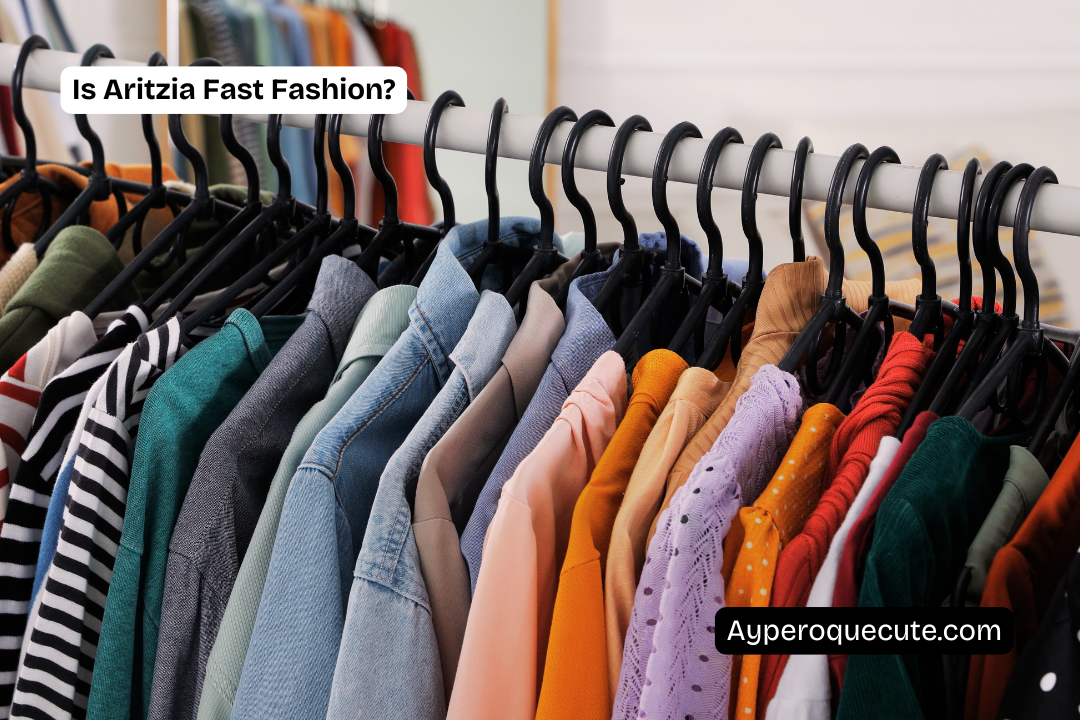
Is Aritzia Fast Fashion? A Complete Guide
Share
Aritzia is a well-known Canadian fashion retailer that has gained a strong following for its stylish, minimalist designs and premium branding. With multiple in-house labels like Wilfred, Babaton, and TNA, Aritzia positions itself as an “everyday luxury” brand, offering clothing that blends trendiness with elevated basics.
Despite its higher price point and boutique-like shopping experience, many consumers question whether Aritzia is truly a slow fashion brand or if it follows the same fast fashion principles as brands like Zara and H&M. The brand’s frequent collection releases, trend-driven designs, and high production volume raise concerns about its sustainability and ethical practices.
This article takes a closer look at Aritzia’s business model, production practices, and sustainability claims to determine whether it fits into the fast fashion category.
Ay Pero Qué Cute is where style meets confidence with trend-driven fashion and beauty. We bring you the latest looks with a touch of authentic Latina flair, making every outfit effortlessly chic. Stay cute, stay bold, stay you.
What is Fast Fashion?
Fast fashion refers to a business model where clothing brands produce large amounts of garments quickly and at a low cost to keep up with the latest trends. These brands prioritize speed and affordability, leading to concerns about environmental impact, ethical labor practices, and garment quality.
Key Characteristics of Fast Fashion Brands
-
High-speed production: New styles are created and stocked rapidly, often within weeks.
-
Frequent new collections: Fast fashion brands release new designs frequently, sometimes weekly.
-
Low-cost materials: Synthetic fabrics and cheaper textiles are commonly used to keep prices down.
-
Trend-driven designs: Products are heavily influenced by runway trends and social media fashion.
-
Sustainability concerns: Large-scale production contributes to textile waste and carbon emissions.
Examples of Well-Known Fast Fashion Brands
Some of the biggest names in fast fashion include:
-
Zara: Known for its rapid design-to-retail turnaround.
-
H&M: Produces affordable, trend-focused clothing in high volumes.
-
Shein: An ultra-fast fashion brand that adds thousands of new styles weekly.
Aritzia’s Business Model: Is It Fast Fashion?
Production & Design Process
Aritzia releases new styles regularly, though not as frequently as brands like Shein or Zara. Its collections are refreshed seasonally, with updated designs that reflect current fashion trends. While this production cycle is slower than ultra-fast fashion, it still follows a model that encourages frequent new purchases rather than long-term wardrobe investment.
The brand uses a combination of high-quality fabrics and synthetic materials. While some pieces are made from wool, silk, and linen, many of their items include polyester blends and other synthetics, which raises concerns about long-term durability and sustainability.
Aritzia also operates under multiple in-house brands, each catering to different styles and preferences. These include:
-
Wilfred: Feminine, minimalist designs.
-
Babaton: Tailored, workwear-inspired pieces.
-
TNA: Casual, streetwear-focused styles.
-
Sunday Best, Denim Forum, and other sub-brands.
This multi-brand strategy allows Aritzia to appeal to a wide customer base and continuously introduce fresh styles.
Pricing Strategy
Aritzia positions itself as a mid-tier fashion brand, with prices significantly higher than traditional fast fashion brands but not as expensive as high-end designer labels. While a basic top at H&M may cost $20, a similar Aritzia top might be priced at $60 or more.
Despite this higher price point, Aritzia still mass-produces its products, meaning it does not operate like true slow fashion brands that focus on small-batch production and sustainable sourcing.
Trend-Driven Approach
Seasonal trends and celebrity fashion heavily influence Aritzia’s clothing. The brand frequently updates its styles to align with what is popular in mainstream fashion, which is a defining characteristic of fast fashion.
Although some of its designs are considered timeless basics, many collections are built around current trends, encouraging consumers to update their wardrobes regularly. This cycle of constant newness and product rotation aligns closely with fast fashion principles.
Is Aritzia Sustainable?
What Aritzia Claims
Aritzia promotes itself as a brand that cares about sustainability. On its website, it highlights efforts like responsible sourcing and the use of eco-friendly fabrics in some collections. The brand also states that it is working toward reducing its environmental impact and improving ethical practices.
Aritzia’s sustainability page features buzzwords like “conscious fabrics” and “better materials,” giving the impression that the company is making meaningful progress. However, there is little detail on how these goals are being met.
Reality Check: Is It Greenwashing?
Despite its sustainability messaging, Aritzia lacks clear evidence of significant environmental action.
-
No strong proof of carbon reduction efforts. The company does not publicly disclose data on how much it reduces greenhouse gas emissions.
-
Lack of transparency. Aritzia scored only 20% on the Fashion Revolution Transparency Index, which means it does not share enough details about its supply chain and production practices.
-
No clear commitment to fair wages. While Aritzia states that it supports ethical manufacturing, there is no concrete information on how workers are treated, what wages they are paid, or if factories are regularly monitored for ethical compliance.
Many fashion brands use sustainability as a marketing tool without making real changes. Based on available information, Aritzia’s sustainability efforts seem more like a branding strategy than a deep commitment to ethical fashion.
How Does Aritzia Compare to Other Fast Fashion Brands?
Aritzia is not as extreme as brands like Shein, but it still follows many fast fashion practices. The table below compares Aritzia to other well-known brands:
|
Brand |
Production Speed |
Pricing |
Sustainability Efforts |
|
Shein |
Extremely fast, new styles daily |
Very cheap |
Almost none, heavy environmental impact |
|
Zara |
Fast, frequent new collections |
Affordable |
Some eco-friendly collections, but still high waste |
|
Aritzia |
Slower than Shein/Zara |
Mid-tier pricing |
Limited transparency, unclear sustainability efforts |
|
Reformation |
Slow production, small batches |
Expensive |
Strong sustainability efforts, ethical sourcing |
Aritzia falls in a middle ground between fast fashion and sustainable fashion.
-
Better quality than ultra-fast fashion brands like Shein but still mass-produced.
-
Not as trend-obsessed as Zara, but still releases new styles frequently.
-
Lacks the strong sustainability efforts of brands like Reformation, which focus on ethical production and low environmental impact.
Final Verdict: Is Aritzia Fast Fashion?
Aritzia is not as extreme as ultra-fast fashion brands like Shein, but it still operates under a fast fashion business model. The company produces a high volume of clothing, frequently updates its collections based on trends, and lacks full transparency in its supply chain and sustainability efforts. While it markets itself as "everyday luxury," many of its practices align with mass-market fashion brands that prioritize sales over sustainability.
Key Factors That Make Aritzia Fast Fashion
-
Frequent Product Releases: While not as rapid as Shein or Zara, Aritzia still introduces new styles regularly, keeping up with seasonal and celebrity-driven trends.
-
High Production Volume: Aritzia manufactures clothing at a large scale, ensuring that its inventory is constantly replenished.
-
Lack of Full Transparency: The company does not disclose clear details about its labor conditions, carbon footprint, or waste management practices.
-
Sustainability Efforts Are Limited: While Aritzia promotes responsible sourcing, there is no strong evidence that it actively reduces environmental harm or ensures ethical wages in its supply chain.
Is Aritzia a Better Choice Than Fast Fashion Giants?
Aritzia does offer better quality than ultra-fast fashion retailers. Its fabrics and construction tend to be superior to brands like Shein, H&M, and Forever 21, which mass-produce clothing at extremely low prices. This means that Aritzia pieces often last longer, making them a better investment for shoppers looking for durability.
However, it is not a truly sustainable or ethical brand. Aritzia still follows a profit-driven model that encourages frequent consumption, trend-driven buying, and high production output.
For shoppers who prioritize style and affordability, Aritzia may be a better option than low-cost fast fashion brands. But for those who want genuinely ethical and sustainable fashion, there are better alternatives available.
Alternatives to Aritzia for Ethical Fashion
If you are looking for stylish clothing that is more sustainable and ethically made, several brands offer high-quality alternatives to Aritzia. These brands focus on responsible sourcing, fair labor practices, and environmentally friendly production while still providing fashionable and well-designed pieces.
Reformation
Reformation is one of the most well-known sustainable fashion brands, offering trendy yet timeless pieces. The company prioritizes eco-friendly fabrics such as organic cotton, linen, and TENCEL™ while implementing low-impact production methods to reduce waste and energy consumption.
Reformation is also transparent about its sustainability efforts, frequently sharing reports on carbon neutrality, water conservation, and ethical sourcing. If you love Aritzia’s sleek and modern designs, Reformation offers similar aesthetics with a stronger commitment to sustainability.
Eileen Fisher
Eileen Fisher is a leader in ethical production and sustainable fashion, focusing on fair wages, responsible labor practices, and high-quality materials. The brand primarily uses organic fabrics and recycled textiles, ensuring minimal environmental impact.
Aritzia, Eileen Fisher designs timeless, minimalist clothing that lasts for years, making it a great choice for anyone looking to invest in long-term wardrobe staples. With a focus on slow fashion, Eileen Fisher proves that sustainability and style can go hand in hand.
ABLE
ABLE is dedicated to fair wages and ethical manufacturing, making it a strong alternative for socially responsible shoppers. The company prioritizes worker empowerment, ensuring that all employees, from factory workers to artisans, earn a living wage and work under ethical conditions.
In addition to clothing, ABLE produces high-quality shoes, accessories, and handbags, all crafted with sustainability in mind. If you are looking for a brand that aligns fashion with social impact, ABLE is a standout choice.
Everlane
Everlane is well known for its radical transparency, providing detailed information about its supply chain, production costs, and sustainability efforts. The brand invests in ethical manufacturing, ensuring that workers are treated fairly and that materials are sourced responsibly.
While Everlane still has areas to improve, it is more transparent than Aritzia in terms of sustainability and factory conditions. Its modern basics and workwear styles make it a great alternative to Aritzia’s Babaton line.
Conclusion
Aritzia presents itself as a luxury alternative to fast fashion, but when examined closely, it still follows many fast fashion business practices. The brand produces a large volume of clothing, keeps up with trends, and lacks full transparency about its labor and sustainability efforts.
While Aritzia is a step up from ultra-fast fashion brands in terms of quality, it does not meet the standards of truly ethical or sustainable fashion.
For conscious shoppers, buying second-hand Aritzia can be a way to enjoy its styles without contributing to new production. However, for those looking for brands that prioritize ethical production and sustainability, options like Reformation, Eileen Fisher, ABLE, and Everlane are better choices.
Before making a purchase, it’s essential to consider not just style and price, but also the impact on the planet and the people behind the clothing.
